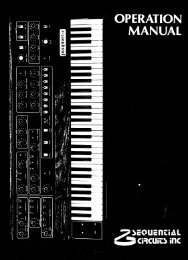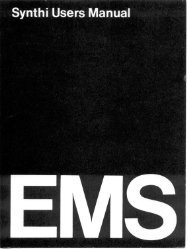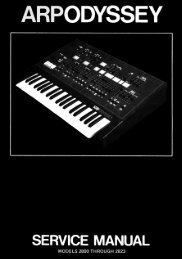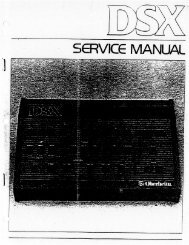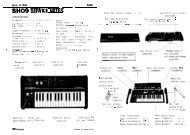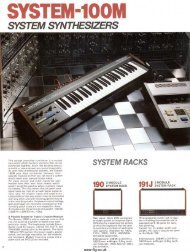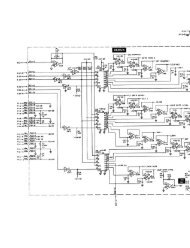ARP2600 - Fundamentals of Music Technology - Cyborgstudio.com
ARP2600 - Fundamentals of Music Technology - Cyborgstudio.com
ARP2600 - Fundamentals of Music Technology - Cyborgstudio.com
Create successful ePaper yourself
Turn your PDF publications into a flip-book with our unique Google optimized e-Paper software.
SECTION SEVEN: ADSR AND AR GENERATORS - 057HOLD IT RIGHT THERE!The next stage <strong>of</strong> the envelope is unique in that it is the first, and only stage to deal with a level instead<strong>of</strong> time. The third stage <strong>of</strong> an envelope is called sustain and it determines the amount <strong>of</strong> control voltagethe EG will put out while a key is being held down. Of course, this creates another little conundrum.How does the EG know when a key is being held down?Yet another pin on the cable which connects the keyboardto the cabinet is used to send voltage to the cabinetas long as a key is being held down. This voltage,which is ‘on’ while a key is held down, is called aTimesustain level gate signal. There is an input for an external gate signalwhich is located just to the left <strong>of</strong> the trigger input.Figure 7-6: SustainOnce again, specific uses will be described later. Aswith the trigger pulse, the manual start button will also produce a gate signal as long as it is held down,so that all the stages <strong>of</strong> the envelope can be heard.VoltageBecause sustain refers to a level and not a time period, the sustain stage sometimes causes some confusion.The time between the end <strong>of</strong> the decay and the beginning <strong>of</strong> the final stage is called the sustain,but the level <strong>of</strong> this stage is also referred to as sustain. The amount <strong>of</strong> time this stage lasts is determinedby the length <strong>of</strong> time a key on the keyboard is held down or the length <strong>of</strong> time the manual start buttonis held down.PLEASE RELEASE ME; LET ME GOFinally, when a key on the keyboard is released, the gate signal being fed to the EG is abruptly cut <strong>of</strong>f,and the EG goes into its final stage, called release. Release determines the time it takes the envelopegenerator to go from the sustain level to no voltage. Release can be seen in Figure 7-7 where the releaseportion <strong>of</strong> the envelope is drawn in red.Taking the first letter <strong>of</strong> each stage, one gets the abbreviation“ADSR” which is pronounced “Add-Sir.”One will frequently refer to the ADSR generator, butthe other generator on the ARP is merely called theA-R generator. Although Bob Moog invented the VCOand VCF, the idea for the ADSR generator was notTimehis. Although the Moog music <strong>com</strong>pany built the firstADSR generators, the module was the idea <strong>of</strong> Russianelectronic music <strong>com</strong>poser Vladimir Ussachevsky (1911-1990), who was Wendy Carlos’s teacherFigure 7-7: Relaseat the Columbia-Princeton Electronic <strong>Music</strong> Center. How are each <strong>of</strong> these times and levels set? TheARP 2600 provides the user with a separate slider for each stage <strong>of</strong> the envelope. With the sliders, onecan almost see a sort <strong>of</strong> graphic representation <strong>of</strong> the envelope about to be produced.Voltage




